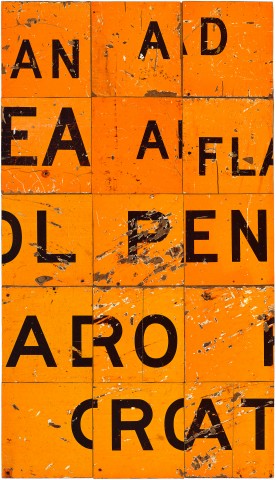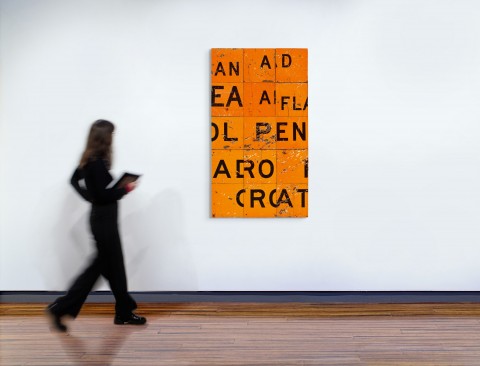PLAZA, 1988
ROSALIE GASCOIGNE
sawn retroreflective plywood road signs on plywood
148.0 x 84.5 cm
signed, dated and inscribed verso: 'Plaza' / 1988 / Rosalie Gascoigne
Roslyn Oxley9 Gallery, Sydney (label attached verso)
Private collection, Sydney, acquired from the above on 26 October 1989
Sotheby's, Sydney, 25 August 2015, lot 14
Private collection, Sydney
Private collection, Sydney
Rosalie Gascoigne, Pinacotheca Gallery, Melbourne, 28 September – 15 October 1988, cat. 2
Rosalie Gascoigne, Roslyn Oxley9 Gallery, Sydney, 31 October – 18 November 1989, cat. 7
Allen, C., 'Bill Robinson; Rosalie Gascoigne', Art Monthly Australia, December 1989 - January 1990, p. 19
MacDonald, V., Rosalie Gascoigne, Regaro, Sydney, 1998, p. 106
Gascoigne, M., Rosalie Gascoigne: A Catalogue Raisonné, Australian National University Press, Canberra, 2019, cat. 336, pp. 234 (illus.), 331, 332
With regular square tiles radiating warmth and marked by palpable traces of human activity, Rosalie Gascoigne’s vibrant orangey-red assemblage, Plaza, 1988 poetically reflects our built environment and its interaction with the larger, untameable landscape. While during the early years of Gascoigne’s foraging practice, she favoured the pale weathered timber of discarded apiary boxes and soft-drink crates, the discovery of a cache of discarded and cut-up road signs in a depot near Collector in 1985 stimulated an unlikely adoption of these bold artefacts into her panel reliefs.1 ‘We all look at road signs an awful lot, and they do get into the consciousness’, she explained.2 These retro-reflective panels emblazoned with stark black capitalised text against high-visibility yellow and red, would become a defining signature material of Gascoigne’s mature works. Plaza was amongst the first works made of the darker hue, one of four exhibited at Pinacotheca Gallery in 1988 (alongside Persimmon, 1987; Chart, 1988; and Party Piece, 1988).
Coming to art in mid-life, Gascoigne’s artworks were infused with the traces of previous experiences and honed talents, for example, an interest in botany and Ikebana or, perhaps more enduringly, a love of language and wordplay – her acute poetic aptitude anchored by having read English at university. Gascoigne had already incorporated text into her works in the form of meaningless brand names from the late 1970s, but it was only through road signs that her mastery of text fragmentation and abstract re-distribution of divorced syllables was fully displayed. The critic Christopher Allen noted this difference in how the artist employed the new road signs, singling out her use of square sections rather than thin strips, and her preference for isolating individual letters and syllables rather than preserving intact words.3 This can be ascribed to the artist’s desire to erase all functional meaning from her original foraged materials, creating in its place a semi-abstract design, with elusive readability. More often than not, a poetry of association can be found in the artist’s choice of title for her finished assemblages. Plaza, like previous works with titles centred around ideas of civil engineering and its associated semiotics, has summery connotations of warm Mediterranean paving stones and outdoor meeting places of organic social congregation.
Plaza is arranged in a strict Modernist grid. Its large vertical rectangle comprises five rows of three identical square units, each with at least one fragment of black text, some with up to two intact letters. The relative size of the lettering is uneven, as is their vertical justification. The effect is airy and scattered, with ‘sequences that can be read across from one tile to another’4 (for example P/EN in the centre right), creating a sensation of fluid horizontal movement. For all of Gascoigne’s apparent adherence to the ultra-modernist rigour of planar and grid-based constructions, painterly surface effects of weathering: scratches, gouges and palimpsests, transform these panels into contemporary expressionist abstractions to be admired for their purely formal qualities. This is further accentuated through Gascoigne’s subtle use of panels bearing retro-reflective film, to be encountered par hasard, ‘meant, like road signs in daylight, to glance and smile at you, then sulk and go away… remain a transient, living, pulsing thing.’5
1. ‘A byproduct of the new road through to Goulburn’, in Gascoigne, M., Rosalie Gascoigne: A Catalogue Raisonné, Australian National University Press, Canberra, 2019, pp. 88, 220
2. Rosalie Gascoigne, ‘Canberra School of Art Lecture’, 1985, cited ibid., p. 221
3. Allen, C., ‘Bill Robinson: Rosalie Gascoigne’, Art Monthly Australia, Dec 1989 – Jan 1990, no. 27, p. 19
4. ibid.
5. Rosalie Gascoigne discussing retroreflection in 1990 with reference to Lamplit, 1989, although the effect is general and applicable to several works, see: Gascoigne, M., Rosalie Gascoigne: A Catalogue Raisonné, ibid., p. 238
LUCIE REEVES-SMITH

